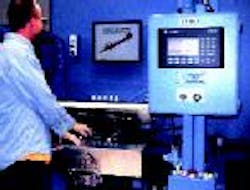Testing system leaks vital part information
Millennium Industries uses a Falcon test system to ensure the integrity of its automotive fuel-rails.
Millennium Industries (www.mill-ind.com), a Michigan-based automotive fuelrail-manifold manufacturing company, wanted immediate feedback on a critical brazing process to identify the presence and locations of potential leaks. Moving its manifold testing closer to that critical process would improve manufacturing efficiency, reduce scrap and allow the company to monitor and correct its fluxing and brazing process. The company required that its test system not be affected by temperature and would need little maintenance.
Fuel-rail manifolds distribute gasoline from a gas tank via fuel lines to fuel injectors mounted at each cylinder of an automobile engine. Manifold construction consists of three to four injector cups, a fuel-regulator mount and fuel-line tubes, all of which must be brazed to a sealed tube.
Leak-tight integrity is critical because of the safety, operating and environmental issues that could arise from gasoline leaking onto a hot engine.
To fulfill its desire to find a moreaccurate and effective system that could be used at its critical brazing process to test for leaks, Millennium turned to the Falcon Leak Test System from Cincinnati Test Systems Inc. (www.cincinnati-test.com).
The helium-based system has chambers designed for each fuel-rail manifold and incorporate strategically placed sensors. The system monitors the sensors to determine leak locations and total leak rates for a manifold under test. The system is accurate and consistent because it functions independently of the fuel-rail manifold's temperature and does not respond to any changes in pressure from temperature variations within each manifold that is being tested.
Because of its temperature neutrality, Millennium integrated the Falcon Leak Test System into its manufacturing process immediately after the brazing furnace. At that point in production, part temperatures typically are higher than 120 F, and they cool rapidly. After each test, the system displays a graphic depiction of the manifold on a screen to show the location of leaks and the rate of leakage. Operators receive immediate alerts so they can adjust fluxing operations to correct the production process.
The testing systems reduced scrap and maintenance as compared with a previously used mass spectrometer vacuum system. Maintenance was reduced because the new system is not as complex as the old system that included a vacuum chamber, a chamber vacuum pump, a mass spectrometer and a backing pump for the mass spectrometer.
